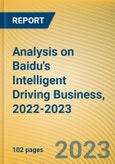Baidu works on three autonomous driving development routes: Apollo Platform, Apollo Go (autonomous driving mobility service platform) and intelligent driving solutions.
On December 28, 2022, Baidu officially launched Apollo 8.0 for all developers, which provides higher usability and makes it easier for developers to operate.
As of July 2022, Baidu had released six generations of production autonomous vehicle products, among which Apollo RT6, the sixth-generation product, is scheduled to be first available to Apollo Go in 2023.
In April 2023, Apollo introduced its flagship product - Apollo City Driving Max. The "lightweight HD map" used in this system is nearly 80% “lighter” than conventional HD maps in the industry. Apollo City Driving Max packs 2 NVIDIA Orin X SoCs with the computing power of 508 TOPS, 2 high-beam LiDARs with a detection range of 180 meters, 7 8MP cameras, 4 3MP surround view cameras, 5 radars and 12 ultrasonic sensors.
Apollo City Driving Max uses only vision to enable urban navigate on autopilot (NOA). In the production stage, LiDAR will be added as a perceptual redundancy.
The new Voyah FREE, which debuted at the Auto Shanghai 2023, carries Apollo Highway Driving Pro, which offers such driving assistance functions as highway pilot, urban driving assist, and all-scenario efficient parking. The solution can provide accurate environmental perception and decision to enable multiple functions such as automated parking, automatic follow and automatic lane change.
In 2023, Apollo Highway Driving Pro was upgraded, with the computing platform upgraded to a single TDA4-VH platform. Moreover, Baidu teamed up with Black Sesame Technologies to deploy Apollo Highway Driving Pro in the HuaShan-2 A1000 chip platform.
Baidu's first-generation Apollo Cockpit-driving Integration uses Qualcomm 8295 (with the AI compute of 30 TOPS equivalent to NVIDIA Xavier) to enable intelligent cockpit and driving assistance functions.
Domain integration represents an important development trend of the intelligent driving industry in 2023. As a part of domain integration, cockpit-driving integration has begun to be laid out by many ADAS companies. Tier1 suppliers such as Baidu, Huawei and Desay SV have deployed their own product lines in the fields of intelligent driving and intelligent cockpit, making it easy for them to develop cockpit-driving integrated solutions.
For most players that only lay out intelligent driving or intelligent cockpits, it is necessary for them to cooperate with others on cockpit-driving integration. At the Auto Shanghai 2023, Banma Zhixing and HoloMatic Technology forged a strategic partnership to co-develop a cockpit-driving integrated solution. This is a typical cooperation case.
This product will be delivered within 3-5 business days.
Apollo Platform
In July 2017, Baidu announced the Apollo program, and released an open-source autonomous driving platform. In late 2018, Baidu officially opened up its Apollo V2X Solution. At present, Baidu Apollo boasts industry-leading solutions in three major fields: autonomous driving, intelligent vehicle and intelligent transportation. Baidu Apollo's vehicle intelligence solutions have been mass-produced for 134 models under 31 auto brands and mounted on a total of over 7 million vehicles.On December 28, 2022, Baidu officially launched Apollo 8.0 for all developers, which provides higher usability and makes it easier for developers to operate.
Robotaxi
By April 2023, Baidu Apollo had tested a total mileage of more than 50 million kilometers, and its mobility brand "Apollo Go" had gone into normal operation in Beijing, Shanghai, Guangzhou, Shenzhen, Chongqing and Wuhan. Apollo Go is expected to cover up to 65 cities by 2025.As of July 2022, Baidu had released six generations of production autonomous vehicle products, among which Apollo RT6, the sixth-generation product, is scheduled to be first available to Apollo Go in 2023.
Intelligent Driving Solutions
Baidu’s intelligent driving product matrix covers: Apollo City Driving Max, Apollo Highway Driving Pro, Apollo Parking, and Apollo Cockpit-driving Integration.In April 2023, Apollo introduced its flagship product - Apollo City Driving Max. The "lightweight HD map" used in this system is nearly 80% “lighter” than conventional HD maps in the industry. Apollo City Driving Max packs 2 NVIDIA Orin X SoCs with the computing power of 508 TOPS, 2 high-beam LiDARs with a detection range of 180 meters, 7 8MP cameras, 4 3MP surround view cameras, 5 radars and 12 ultrasonic sensors.
Apollo City Driving Max uses only vision to enable urban navigate on autopilot (NOA). In the production stage, LiDAR will be added as a perceptual redundancy.
The new Voyah FREE, which debuted at the Auto Shanghai 2023, carries Apollo Highway Driving Pro, which offers such driving assistance functions as highway pilot, urban driving assist, and all-scenario efficient parking. The solution can provide accurate environmental perception and decision to enable multiple functions such as automated parking, automatic follow and automatic lane change.
In 2023, Apollo Highway Driving Pro was upgraded, with the computing platform upgraded to a single TDA4-VH platform. Moreover, Baidu teamed up with Black Sesame Technologies to deploy Apollo Highway Driving Pro in the HuaShan-2 A1000 chip platform.
Baidu's first-generation Apollo Cockpit-driving Integration uses Qualcomm 8295 (with the AI compute of 30 TOPS equivalent to NVIDIA Xavier) to enable intelligent cockpit and driving assistance functions.
Domain integration represents an important development trend of the intelligent driving industry in 2023. As a part of domain integration, cockpit-driving integration has begun to be laid out by many ADAS companies. Tier1 suppliers such as Baidu, Huawei and Desay SV have deployed their own product lines in the fields of intelligent driving and intelligent cockpit, making it easy for them to develop cockpit-driving integrated solutions.
For most players that only lay out intelligent driving or intelligent cockpits, it is necessary for them to cooperate with others on cockpit-driving integration. At the Auto Shanghai 2023, Banma Zhixing and HoloMatic Technology forged a strategic partnership to co-develop a cockpit-driving integrated solution. This is a typical cooperation case.
This product will be delivered within 3-5 business days.
Table of Contents
1 Overview of Baidu
2 Apollo (Autonomous Driving Open Platform)
3 Intelligent Driving Domain Controllers
4 Autonomous Shuttle
5 Electronic Maps and Positioning Services
6 V2X Business
Companies Mentioned
- Baidu
Methodology

LOADING...








